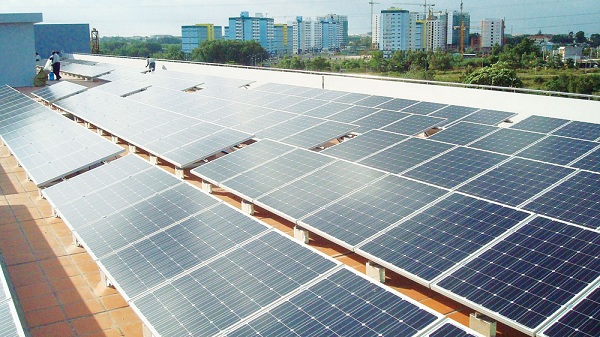The fact and the target
The adjusted Master Plan VII requested to speed up progress of solar power generation projects, including the focused power generation installed on the ground and separated power generation installed on the house roofs, increasing the current inappreciable solar power capacity to around 850 MW in year 2020 and about 4,000 MW in year 2025.
Mr. Nguyen Duc Cuong – Director of Renewable Energy and Clean Development Mechanism Center (Institute of Energy, Ministry of Industry and Trade) shared, in previous years, it was needed a quite big investment rate to develop the solar power generation. But now, the investment rate is more interesting, fluctuating from 1,400 – 1,800 USD/kWh (depend on each location) and have decreasing tendency. Some countries producing solar batteries show the investment rate is only about from 1,100 - 1,300 USD/kWh. Besides, the Government has assigned ministries and relevant parties to develop mechanisms to support the development of solar power projects, such as power tariffs, together with the tax incentives (income tax, equipment import tax, infrastructure).
Currently, Vietnam has more than 30 major investors (domestic and foreign) have been established to promote solar power projects with capacity from 20 MW to over 300 MW at some potential localities, concentrated in the Central region. A solar power project with capacity of 19.2 MW was started in August 2015 in Mo Duc district, Quang Ngai province. There are about 5-6 other projects being completed the required procedures and documents for adding in Master Plan and getting investment permits.
Regarding the wind power, About 140 MW have been installed and operating in Vietnam. More than 500 MW of nearly 10 projects are being invested in the Mekong Delta river region and Southern Central area. There are 6 provinces having plans for wind power with expected total installed capacity is over 1,000 MW by 2020. However, the biggest challenge for the development of wind power (both mainland and onshore) is that the current power tariffs are not really attractive to investors.
Mr. Cuong confirmed that: “From now to 2020, more than 4 years left for Vietnam to develop renewable power generation source in accordance with the Master Plan VII (adjusted version). Averagely, there are about 400 MW (including solar and wind power) to be installed each year. However, if barriers are not soon released, supportive policies and mechanism are not promulgated, it will be very difficult to realize the targets".

The solar battery system was installed on the roof of Institute of Environment and Nature – Hochiminh City National University. Source: Internet
It is needed to release barriers
Mrs. Pham Cam Nhung – Manager of Renewable energy program of WWF - Vietnam shared: the renewable energy is an indispensable element for sustainable development of Vietnam in the future. Vietnam is absolutely able to become a country which powerfully and efficiently develops clean and renewable energy. The target of year 2015 is to provide at least 35% solar power and 15% wind power of the total power demand of Vietnam.
To achieve above-mentioned goal, according to Nguyen Duc Cuong, the most critical issue now is to design and promulgate appropriate electricity tariffs for wind and solar power, to harmonize benefits of three parties, which is: investors (the power seller), EVN (the power buyer) and the development goal of the Government on green power - no greenhouse gas emission. Accordingly, the Government should issue mechanisms on supporting the development of solar power.
In addition, most of wind and solar power generation projects have not yet included in the Plans of localities, it takes a long time to complete documents and procedures to add them into the Plans. Therefore, the Government should issue national and local plans for development of renewable energy to create favorable conditions for developing these energy sources in the near future.
According to Nguyen Duc Cuong also, the development goals for wind and solar energy by 2030 of Mater Plan VII (adjusted) are much more ambitious than that of year 2020, with a capacity of 6,000 MW of wind power and 12,000 MW of solar power. This means, the wind power will increase nearly 8 times and solar power will increase 15 times. This is not only the goal, but also a huge challenge for the Government Authorities, EVN and investors. Hence, the Government and relevant ministries should soon do research and develop mechanisms binding to investors who produce power from fossil fuels. For example, by the year 2020, investors expected to develop coal power with 1,000 MW capacity shall own at least 5% of power generation from renewable energy. Correspondingly, by 030, investors shall own at least 10% wind power or solar power if they want to develop coal fired power or other kind of power generations, etc. Only when the above-mentioned requirements are satisfied, can the goal of renewable energy development mentioned in Master Plan VII (adjusted) be realized.
Developing power generation from renewable energy in accordance with Master Plan VII (adjusted):
|
Year
|
Capacity (MW)
|
Proportion
in total installed capacity (%)
|
Total energy (TWh)
|
Proportion in total energy (%)
|
|
2015
|
2.046
|
5.2
|
6,047
|
3.7
|
|
2020
|
6.004
|
9.9
|
17,265
|
6.5
|
|
2025
|
12.009
|
12.5
|
27,761
|
6.9
|
|
2030
|
27.199
|
21.0
|
60,907
|
10.7
|
(Source: Institute of Energy, Ministry of Industry and Trade)
evn.com.vn
Share